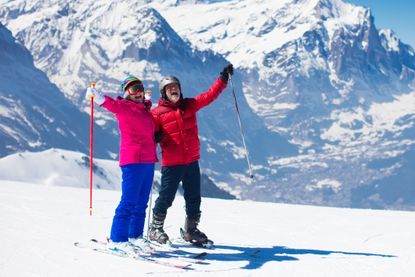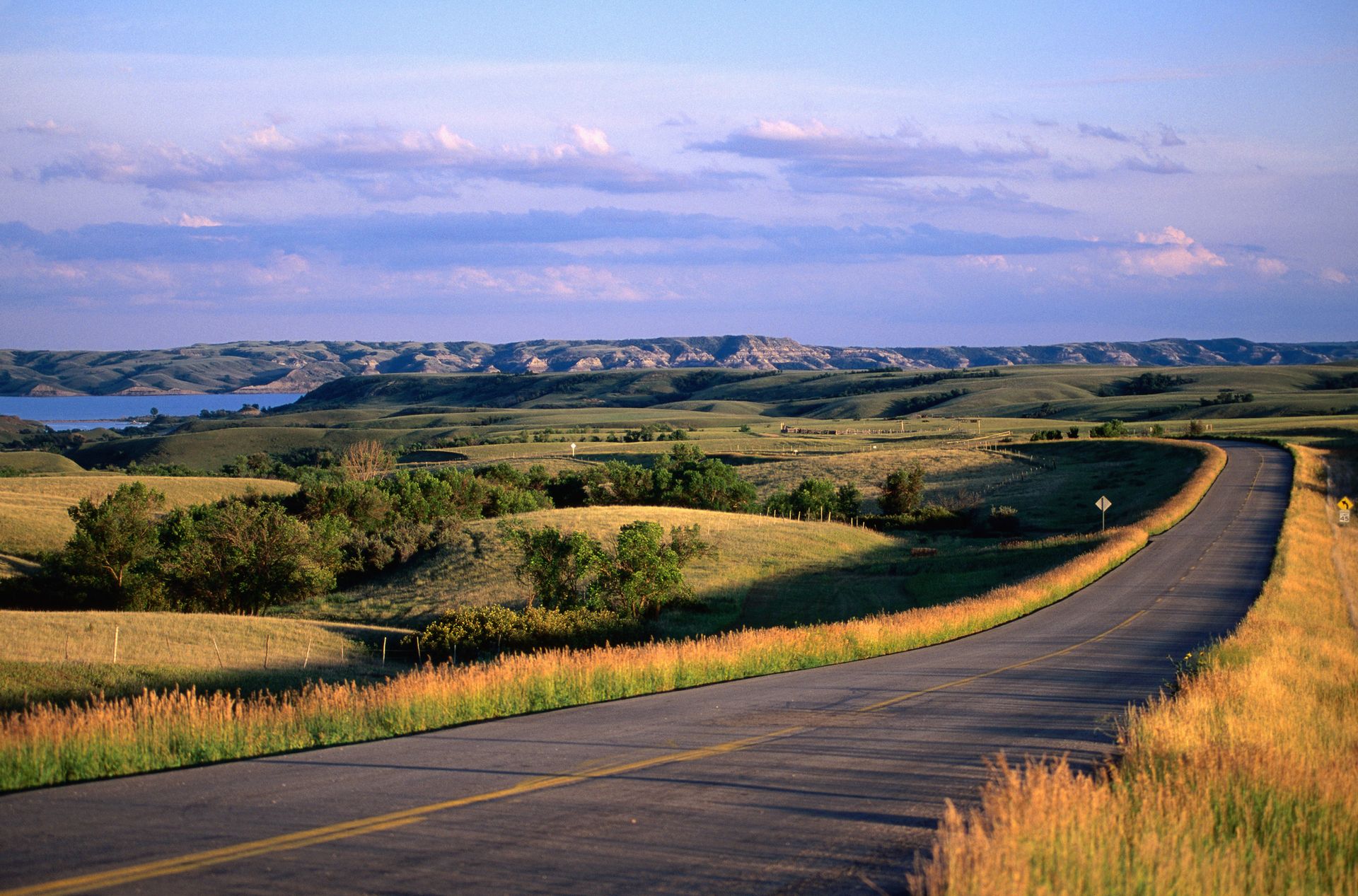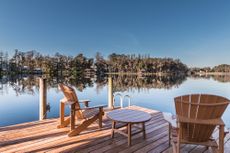12 Places to Retire If You're Sick of the Heat
Some like it hot in a place to retire; others not so much.
- (opens in new tab)
- (opens in new tab)
- (opens in new tab)
- Newsletter sign up Newsletter


Some like it hot; others not so much. If you dream of a retirement destination where you get to bundle up for long winters and enjoy jacket weather in the summertime, then head north.
Many of the following locales offer an abundance of winter activities, such as skiing and snowshoeing, as well as a number of other year-round benefits, including low taxes and affordable living costs.
To assess these places to live in retirement, Kiplinger took a look at average temperatures, the cost of living, share of population over 65, and Kiplinger's ratings of tax friendliness.
Check out these extra-cool spots if you're looking to chill out when you retire.
Estimates of living costs for retirees, where available, come from PayScale. Populations and median home values are from the U.S. Census Bureau. Tax rankings are based on Kiplinger's Retiree Tax Map, which divides states into five categories: Most Tax-Friendly, Tax-Friendly, Mixed, Not Tax-Friendly and Least Tax-Friendly. Crime statistics are from the FBI. Average temperatures are from The National Oceanic and Atmospheric Administration. Retirement destinations are listed in alphabetical order by state.

Juneau, Alaska
- Average low temperature in January: 26℉
- Average high temperature in July: 63℉
- Cost of living: 28% above U.S. average
- Share of population 65+: 13.9%
- Alaska's tax rating for retirees: Mixed
- SEE ALSO: Great Places to Retire in All 50 States
Seniors seem interested in facing the Last Frontier in retirement; 13.9% of the entire state's population is age 65 and older. If you crave adventure — and don't mind long winters and vast swaths of wilderness — it pays to live in Alaska. Literally. The state's oil wealth savings account gives all permanent residents an annual dividend. In 2022, the payout was $3,284 per person. Plus, Alaska has no state income tax or sales tax (although municipalities may levy a local sales tax), and the state doesn't tax Social Security or other retirement benefits.
"When you’re thinking about what it’s like to live in Alaska, there are tons of reasons why you’re going to want your loved one to live here. Starting with the beautiful front-row view of the Northern Lights to the ability that they have when it comes to seeing wildlife up close and personal at any given time," states Baxter Senior Living.
The capital city offers seniors an additional tax perk. For $20, residents age 65 and older can purchase a card that exempts them from the local 5% sales tax. It entitles you to free bus rides, too. Naturally, Juneau offers endless outdoor activities, from kayaking to whale watching, as well as a charming downtown.

Des Moines, Iowa
- Average low temperature in January: 9℉
- Average high temperature in July: 81℉
- Cost of living: 14% below U.S. average
- Share of population 65+: 17.1%
- Iowa's tax rating for retirees: Least Tax-Friendly
There are retirement destinations of all sizes to choose from in Iowa, one of our 20 best states for retirement. For retirees looking to live in a big city on a small budget, Des Moines is a good choice. Affordability is just one reason the Milken Institute ranked the state one of the best cities for successful aging. Des Moines also boasts a strong economy, numerous museums and arts venues, and plenty of health care facilities specializing in aging-related services.

Bangor, Maine
- Average low temperature in January: 9℉
- Average high temperature in July: 81℉
- Cost of living: not available
- Share of population 65+: 17.1%
- Maine's tax rating for retirees: Mixed Tax Picture
The cold never bothered you anyway? Then Bangor is a lovely retirement destination. The area's great outdoors offer cross-country skiing and snowshoeing, as well as dog-sledding and snowmobiling. In the warmer months, the same trails can be used for walking, hiking or biking. And the waterfront along the Penobscot River is home to the annual American Folk Festival, as well as other concerts during the summer. Plus, despite being home to the King of Horror, Stephen King, you have little to fear in Bangor — there were only 35 violent crimes reported in 2019.
While the Pine Tree State can be painfully pricey, the relatively small city (population: 31,921) is more affordable than other well-known areas such as Kennebunkport (where the wealthy Bush clan has a compound) and Mount Desert (a favorite of the Rockefellers). The median home value in Bangor is $162,900, compared with $212,100 for the state.

Pittsfield, Massachusetts
- Average low temperature in January: 14℉
- Average high temperature in July: 80℉
- Cost of living: 10% above average
- Share of population 65+: 19.8%
- Massachusetts's tax rating for retirees: Not Tax-Friendly
New England is notoriously expensive, but Pittsfield offers a small pocket of relative affordability. Overall, living costs are higher than the national average, but they're more reasonable than in Boston, where the cost of living is 50% above the U.S. average, or Cambridge, at 73% above average. Housing is also notably affordable: The median home value in the city is $183,600, compared with $424,700 for all of Massachusetts, $610,400 for Boston proper and $888,000 in Cambridge.
Leaf peeping in the fall may be enough to draw you to the Berkshires. But you have plenty to enjoy all year round, including excellent sites for camping, fishing, hiking and skiing. You can also enjoy musical performances at the nearby Tanglewood Music Center, the summer home of the Boston Symphony Orchestra.

Ann Arbor, Michigan
- Average low temperature in January: 17℉
- Average high temperature in July: 84℉
- Cost of living: 4% above average
- Share of population 65+: 12%
- Michigan's tax rating for retirees: Not Tax-Friendly
Another college town well suited to retirees, Ann Arbor is home to the University of Michigan with all its educational programs (including the Osher Lifelong Learning Institute), sporting events and cultural affairs. The university also runs the Geriatrics Center and Institute of Gerontology, which focuses on health care issues that come with aging. Along with its research and medical facilities and staff, the Center offers programs and classes to help older adults maximize their good health and independence.
In fact, Ann Arbor's health care facilities are top-notch, earning it a ranking as one of the best small metro areas for successful aging, according to the Milken Institute, a think tank. Along with quality health care, Milken recognizes the area's public transportation options as a winning attribute for older residents. A downside, however, is affordability. The median home value is $366,600, versus $172,100 for the rest of the state.

Rochester, Minnesota
- Average low temperature in January: 5℉
- Average high temperature in July: 81℉
- Cost of living: 0% difference from national average
- Share of population 65+: 15%
- Minnesota's tax rating for retirees: Not Tax-Friendly
- SEE ALSO: Great Places to Retire in All 50 States
If the cold winters and equally harsh tax situation don't put you off of the North Star State, Rochester is a great place to retire. In fact, the Milken Institute rates it as the seventh-best small metro area for successful aging. It offers an abundance of health care providers, including the renowned Mayo Clinic; hospital units specializing in Alzheimer's; and top-rated nursing homes. The local population also exhibits a healthy lifestyle, with long life expectancies and low obesity rates.
Housing costs won't wipe out your nest egg. The median home value in Rochester is $236,400, below the state median of $250,200.

Great Falls, Montana
- Average low temperature in January: 19℉
- Average high temperature in July: 87℉
- Cost of living: not available
- Share of population 65+: 19.3%
- Montana's tax rating for retirees: Mixed Tax Picture
Adventurous retirees (with a high threshold for cold winters) can thrive in Great Falls, located on the high plains of Montana's Rocky Mountain Front Range. This portion of Big Sky Country hosts its fair share of hiking, skiing, mountain biking and kayaking. The area has about 60 parks and 40 miles of trails along the scenic Missouri River. If that's not enough, Yellowstone and Glacier national parks can be great weekend-trip destinations; they're about four and three hours away, respectively.
The cost of living is relatively affordable. The median home value in Great Falls is $190,300, compared with $263,700 in Montana.

Peterborough, New Hampshire
- Average low temperature in January: 11℉
- Average high temperature in July: 80℉
- Cost of living: 14% above national average
- Share of population 65+: 26.9%
- New Hampshire's tax rating for retirees: Not Tax-Friendly
Where better to retire and "realize life while you live it — every, every minute" than the place that (in part) inspired Our Town's Grover's Corners? Renowned author and playwright Thornton Wilder spent many summers in Peterborough and penned portions of his most famous play at the MacDowell Colony. The artist retreat continues its mission today, hosting and inspiring talented individuals while they create. And it invites the community to its various exhibitions every first Friday of the month from March to November for free.
The real-life representation of classic small-town America, Peterborough is a peaceful home to about 6,284 people. There's a nice selection of restaurants in town and plenty of outdoor recreation to enjoy, including nearby snowshoeing, hiking, skiing and just taking in the scenic mountain views. The town's recreation department also offers a senior fit program with exercise classes.

Bismarck, North Dakota
- Average low temperature in January: 1℉
- Average high temperature in July: 85℉
- Cost of living: 0% difference from national average
- Share of population 65+: 17.2%
- North Dakota's tax rating for retirees: Mixed Tax Picture
The capital of the Peace Garden State offers a strong economy that allows your retirement to bloom. Especially if you're considering an encore career, Bismarck is a good choice. It boasts employment opportunities for older adults, particularly in the service sector and has a robust presence of quality health care.
If you're hoping for a more leisurely retirement, there are a number of biking and hiking trails and parks around the city, as well as on the banks of the Missouri River. You can also enjoy cruising, boating, kayaking and canoeing the river during warmer months. Living costs are on par with the national averages but pricier than most of the rest of the state. The median home value in Bismarck is $254,400, while the rest of the state sports a $209,900 median.

Sioux Falls, South Dakota
- Average low temperature in January: 6℉
- Average high temperature in July: 85℉
- Cost of living: 8% below U.S. average
- Share of population 65+: 13%
- South Dakota's tax rating for retirees: Not Tax-Friendly
If you've never considered moving to South Dakota, perhaps you should. For one thing, it's really easy to avoid crowds there. The entire Mount Rushmore State is home to fewer than 900,000 people. But Sioux Falls is filled with advantages, including a booming economy, low unemployment, hospitals specializing in geriatric services. For all these reasons, plus the city's recreational activities (including regularly scheduled pickleball), the Milken Institute dubbed Sioux Falls as one of the best small metro areas for successful aging.
The median home value in Sioux Falls is $152,200, compared with $187,800 for the state.

Burlington, Vermont
- Average low temperature in January: 10℉
- Average high temperature in July: 81℉
- Cost of living: 16% above U.S. average
- Share of population 65+: 11.6%
- Vermont's tax rating for retirees: Least Tax-Friendly
This small mountain city on the shores of Lake Champlain is a picturesque setting for tree-hugging retirees. Outdoor recreation is plentiful with miles of hiking and biking paths, nearby beaches where you can swim, kayak or paddleboard in the warmer months, and numerous skiing options in the area. An eco-friendly vibe permeates the town, from the businesses bolstering the city's economy, such as household-products maker Seventh Generation, to the local food movement feeding the neighborhood.
But being green isn't easy on your wallet. Taxes and living costs are high. The median home value is $240,600 in the Green Mountain State and $338,100 in Burlington. However, at least you can save money on academic pursuits; the University of Vermont will cover tuition costs for state residents age 65 and older who wish to take a class or more, even if it's for credit.

Madison, Wisconsin
- Average low temperature in January: 8℉
- Average high temperature in July: 83℉
- Cost of living: 3% above U.S. average
- Share of population 65+: 12.1%
- Wisconsin's tax rating for retirees: Least Tax-Friendly
- SEE ALSO: Great Places to Retire in All 50 States
The Badger State capital and home to the University of Wisconsin, Madison has a strong economic base to support a thriving retirement. That's part of what makes it one of the best city for successful aging among 100 large metro areas, according to the Milken Institute. Other winning attributes: an abundance of quality health care, academic and other opportunities afforded by the university, and plenty of museums, libraries and recreational facilities.

Rapacon joined Kiplinger in October 2007 as a reporter with Kiplinger's Personal Finance magazine and became an online editor for Kiplinger.com in June 2010. She previously served as editor of the "Starting Out" column, focusing on personal finance advice for people in their twenties and thirties.
Before joining Kiplinger, Rapacon worked as a senior research associate at b2b publishing house Judy Diamond Associates. She holds a B.A. degree in English from the George Washington University.
- Erin BendigPersonal Finance Writer
-
-
 Stock Market Today: UPS, First Republic Earnings Drag on Stocks
Stock Market Today: UPS, First Republic Earnings Drag on StocksDismal guidance from logistics giant UPS and dreary deposit data from regional lender First Republic kept a lid on the major indexes Tuesday.
By Karee Venema • Published
-
 Skip These Fees When You Head Overseas
Skip These Fees When You Head OverseasForeign-transaction fees can add up when you make purchases abroad, but there are ways to bypass them.
By Emma Patch • Published
-
 5 Great Places to Buy a Vacation Home
5 Great Places to Buy a Vacation HomeWith remote work on the rise, more people are looking for a permanent getaway.
By Ellen Kennedy • Published
-
 10 Big U.S. Cities With the Cheapest Apartment Rents
10 Big U.S. Cities With the Cheapest Apartment Rentsplaces to live Apartment dwellers pay less than the national average in these cities with the cheapest rent.
By Dan Burrows • Last updated
-
 The 11 Most Expensive Cities to Live in the U.S.
The 11 Most Expensive Cities to Live in the U.S.real estate From metro areas on both coasts to the middle of the Pacific Ocean, these are the most expensive cities to live in the U.S.
By Dan Burrows • Last updated
-
 How 12 Types of Retirement Income Get Taxed
How 12 Types of Retirement Income Get Taxedretirement Don't forget about taxes on your pensions and other retirement income while planning for your golden years.
By Joy Taylor • Last updated
-
 The 25 Cheapest Places to Live: U.S. Cities Edition
The 25 Cheapest Places to Live: U.S. Cities Editionplaces to live Have a look at the cheapest places to live in America for city dwellers. Is one of the cheapest places to live in the U.S. right for you?
By Dan Burrows • Last updated
-
 10 Least Tax-Friendly States for Middle-Class Families
10 Least Tax-Friendly States for Middle-Class Familiesstate tax It can cost your family thousands of dollars each year if you end up in one of the worst states for taxes after a move.
By David Muhlbaum • Published
-
 10 Most Tax-Friendly States for Middle-Class Families
10 Most Tax-Friendly States for Middle-Class Familiesstate tax If a move from one state to another is in your future, you could save big bucks by relocating to one of these states where the tax bite is light for middle-class families.
By David Muhlbaum • Published
-
 15 States That Tax Military Retirement Pay (and Other States That Don't)
15 States That Tax Military Retirement Pay (and Other States That Don't)retirement Taxes on military retirement pay vary from state-to-state. How generous is your state when it comes to helping retired veterans at tax time?
By Sandra Block • Published










